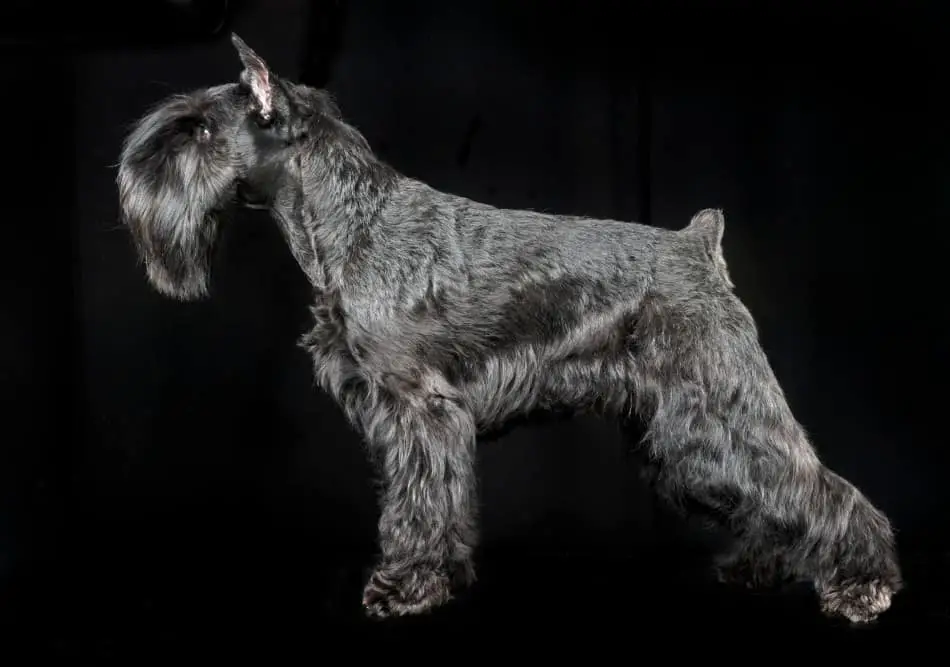Our Miniature Schnauzer, Livi, has a docked tail but has kept her naturally floppy ears. The docking had been performed before we purchased her from the breeder, so we missed out on having a say in that procedure. When our kids asked why she had such an odd-looking tail, I had to do some quick research about the original purpose of the practice. I also wanted to know why it is still an acceptable modern-day procedure and whether or not it’s even currently legal. Here’s what you need to know.
Why are Schnauzers’ tails docked and ears cropped, and is it legal? Historically, Schnauzers’ tails were docked and ears were cropped to protect them from injury while hunting vermin and protecting German farms. While the look has become a breed standard, the practices are debated and are currently illegal in Canada, parts of Europe, New Zealand, some U.S. states, and more.
Tail docking and ear cropping are practices that began centuries ago, but are they acceptable and legal today?
For Schnauzers specifically, the idea was to create an alert appearance and prevent injury as they worked as guard dogs and hunted for small rodents.
Cropping the ears, for example, eliminated anything rats or other small rodents could hold on to if they were to attack a Schnauzer. Longer tails were docked to decrease the risk of being injured during a chase. Both guard dogs and hunting dogs with longer tails were easy to grab during an attack.
In addition, with Schnauzers being a working and hunting breed on German farms, there was always the risk of their tails or ears becoming entangled in farm equipment.
Because of these fears, ear cropping and tail docking became a Schnauzer breed standard, although some countries (New Zealand, Australia, and countries in the European Union) have now outlawed the practice hailing it as inhumane.
I’ll detail countries and a link to the U.S. states in which these practices are currently illegal later in this article, so feel free to jump down to that section if you need to know.
For now, it helps to understand how the practice even began and where it currently stands with modern-day, domesticated Schnauzers.
The History of Cropping and Docking
The first recorded occurrence of tail docking took place in Ancient Rome. Romanian shepherds believed that the practice prevented rabies, strengthened a dog’s back, and increased its speed. They also believed tail docking prevented injuries when fighting, baiting, and ratting as a Schnauzer’s tail is naturally long. The shepherds removed the top part of the dog’s tail 40 days after birth.
The practice was also a result of the 18th-century taxation law that required dog owners to pay tax on their dogs unless it was a working dog. As a result, dog owners cut off dog’s tails to distinguish working dogs from non-working ones. While the law was repealed in 1796 and the rabies vaccine discovered in 1885, dog owners continued unabated.
How and When it Became the Breed Standard
Modern ear cropping and tail docking are believed to stem from the book “The American Book of the Dog” published in 1891. The book idealizes the practice as being the proper look for Schnauzers.
Also, the mid-1950s rules for pedigree dog shows in the United States formalized the docking tradition for some breeds, including the Schnauzer. The dog shows allowed the culture regardless of the original basis for the practice.
Modern dog owners continue with the practice for therapeutic and prophylactic purposes, and to prevent injury. They explain that tails collect burrs causing pain and infection. They add that tail wagging is subject to abrasion and other injuries when running through thickets and bushes, hence the need for tail docking.
Historically, some Schnauzer owners have believed that tail bones may be broken due to possible impact in various situations. The possibly of broken tail bones can lead to spinal injuries, and tail docking protects the Schnauzer from trauma or severe spinal injury.
Other less transparent reasons of tail docking are to ensure effortless control of Schnauzers in dog shelters and to prevent a potential pile-up of fecal matter around the tail. Fecal matter on the tail can potentially cause worm invasion and fly irritation.
Additional studies show that breeders docked tails to improve hygiene and to increase aggression.
In summary, the original reasons for docking and cropping stemmed from valid guarding, hunting, and farm work reasons. The subsequent reasoning behind maintaining the practices as the Schnauzer breed standard are probably less valid as Schnauzers have become more domesticated companions.
What Do Schnauzers’ Natural Tails and Ears Look Like?

All Schnauzer breeds (Miniature, Standard, and Giant) are born with naturally longer tails covered in their iconic wavy hair.
Their ears are medium-sized and floppy. They perk up at sounds and interest, but are loose and floppy when relaxed.
What Do Docked Tails and Cropped Ears Look Like?

Docked tails are surgically trimmed to a point of leaving approximately 2 inches of the original tail. Even the shortened tail can move and wag.
Cropped ears are surgically trimmed to remove excess tissue and then propped up during healing. This trains the remaining ear tissue to stand erect at all times.
How, and at What Age, is Docking and Cropping Performed?
Tail docking and ear cropping are both surgeries requiring anesthesia and a skilled veterinarian. Ear cropping is becoming less common, but tail docking is still quite routine.

Tail Docking
Tail docking is the removal of portions of a dog’s tail, including tendons, nerves, muscles, and ligaments. The procedure is performed in two ways. The first involves tying a rubber ligature around the tail to constrict blood supply for a few days until the tail has fallen off. The second method involves cutting off the tail using a scalpel or surgical scissors.
If not done correctly, the bones are crushed or broken, nerves, ligaments, tendons, and muscles crushed or torn. Traditionally, the procedure was done without analgesics in the belief that a pup’s nervous system is immature.
Today, the procedure is performed between days three and five of the puppy. Its tail is measured, and the amputation made on the appropriate vertebrae. Absorbable stitches are used to ensure the dog has a cosmetically healed tail, i.e., skin closes over the bone instead of a cut off a part of the tail.
Ear Cropping
Ear cropping is intended to trim shape the naturally floppy ears into smaller, erect ears. The veterinarian will measure and mark the Schnauzer’s ears to mark the location of the incisions. After the ears are cut and shaped, they are disinfected and stitched.
The ears are propped and bandaged after surgery to allow them to heal in an erect position. The bandages need to be changed every week to keep the ears propped until they stand on their own, and the Schnauzer will need after-care and pain reliever. Most Schnauzers heal after 4-8 weeks.
Ear cropping is performed on puppies at the age of 8-12 weeks. Experts recommend having the procedure performed by a licensed veterinarian as it requires skill and precision to ensure the ears appear as intended after healing, and that no damage occurs.
Pros and Cons of Ear Cropping and Tail Docking
The practices of ear cropping and tail docking continue to be hotly debated. Some argue that the practices are tortuous and inhumane, especially since they are now purely cosmetic.
Others suggest that the practices, although not necessarily needed for a Schnauzer’s hunting protection, actually offer some health and hygiene purposes.

Here are some of the opinions and research.
Ear Cropping
Some veterinarians argue that cutting a dog’s auricle (the outer part of a dog’s ear) prevents ear infection and trauma while others state the procedure is no different from neutering and spaying.
Additionally, upright ears are believed to allow detectable expressions compared to drop ears, meaning that we can potentially read and understand our Schnauzers better.
Proponents of ear cropping argue that it reduces ear infections. This argument does not hold as the most common risk of ear infection is a genetic predisposition. While dogs with long, floppy ears are susceptible to ear infections, it is not necessarily the case with the Schnauzer breed.
The general modern belief is that ear cropping is purely cosmetic and that Schnauzers should not be subjected to something so painful. In fact, as we’ll discuss shortly, the practice is illegal in a growing number of countries
“The practices of ear cropping and tail docking continue to be hotly debated.”
THE SCHNAUZER COLLECTIVE
Tail Docking
Outside of the risk of injury during hunting or working, there aren’t many current pros to docking a Schnauzer’s tail. Although it is still quite a common practice, it is also illegal in many countries.
Most veterinarians believe that it inhibits a Schnauzer’s ability to communicate adequately. The ability to wag a tail is a common form of expression, and docking essentially eliminates it.
In addition, a study about the causes of acquired incompetence of the urethral sphincter showed docked dogs were more likely to develop the problem compared to healthy dogs. The same study also reported puppies were more likely to develop weakened sphincter muscles after the procedure.
There is also the argument that tail docking affects a dog’s stability. The tail enhances a dog’s balance, especially when jumping, running at high speed, balancing, or turning sharply. Tail docking is likely to affect all such functions.
Some believe that tail docking is painless. This is not true. The tail is an appendage with nerves, muscles, and blood vessels. While all Schnauzers should be anesthetized, the recovery process is painful even for puppies as their central nervous system is just as developed as that of an adult dog.
There is slight evidence that tail docking predisposes the Schnauzer to unnecessary aggression. Two scientists at the University of Victoria arrived at this conclusion after a series of observations on 492 dogs. They realized that tail docking deprived dogs of the ability to express their intentions and their counterparts were more likely to approach them more cautiously.
Why Ear Cropping and Tail Docking is Considered Illegal
Tail docking and ear cropping remain a highly controversial subject with some scientists advocating for the procedure as others condemn it. In a statement released in November 2008, the American Veterinarian Medical Association (AVMA) criticized the practice, especially if done for cosmetic reasons. AVMA also encouraged the elimination of tail docking and cropping from dog breeding standards.
The association argued that dogs don’t derive pride or self-esteem from the procedures. On the contrary, they only please the owner. In AVMA’s opinion, this is an insufficient reason for performing surgical procedures.
Where is Ear Cropping Illegal?
Ear cropping is currently banned in Scandinavian countries, Australia, New Zealand, and parts of Canada. It is still an acceptable practice in the United States, although there are now restrictions in some states.
The AVMA has also documented the cosmetic surgery laws currently adhered to in the United States. Currently, there are only several states who regulate these practices. If you state does not currently regulate tail docking or ear cropping, it’s up to you to make an informed and proactive decision. Work with the breeder of your choice along with a licensed veterinarian.
Where is Tail Docking Illegal?
It’s considered by many to be inhumane and is currently banned in Germany, England, Australia, Norway, Sweden, Greece, and Switzerland. It is still an acceptable practice in the United States, although there are now restrictions in some states. Please check your own area for any restrictions.
What Are Your Humane and Legal Cropping and Docking Options?
Naturally bobbed animals (animals with genetically short tails) are not considered docked. However, since Schnauzers do not have bobbed genetics, Schnauzer owners should be cautious about the procedure if they reside in countries that restrict it.
As I just mentioned, tail docking is still acceptable parts of the United States, but it is illegal in Australia, Germany, Norway, Sweden, England, Switzerland, and Greece. Ear cropping, on the other hand, is banned in Australia, New Zealand, some parts of Canada, and in Scandinavian countries.
However, if the procedure is a result of medical reasons it is not referred to as docking. For example, your veterinarian may recommend partial or complete amputation after a traumatic injury where tail repair is not possible.
It may also be suitable where the Schnauzer has tail deformities that affect normal function or if it increases the risk of injury. Additionally, if the dog has experienced repeated tail injury, docking may be appropriate. Puppies with congenital disabilities may also undergo tail docking as a precautionary measure.
You should know that you, as the Schnauzer owner, may be required to provide evidence in the form of impartial expert opinion. Please check with your state or country for the legality of these practices and to confirm what type of documentation you might need.
Fun Fact: The Beards are Protection
Many dogs have furry faces, but Schnauzers actually have what we can all agree is a “beard.” But why?
The fundamental reason is very similar to why tail-docking and ear-cropping became a common practice.
All three Schnauzer breeds (giant, standard, and miniature) have resulted from centuries of cross-breeding with various other dog breeds. The Standard Schnauzer (the original Schnauzer breed) is thought to be the product of crossing the gray Wolf Spitz or the black German Poodle with the wire-haired Pinscher. The Giant Schnauzer and the Miniature Schnauzer are the result of even further cross-breeding.
With all of the cross-breeding designed to create what we know as Schnauzers, the purpose was to end up with a strong, hearty, hard-working dog….with a beard.
When it comes to their beard specifically, the fact is that what has become a striking Schnauzer show dog feature began as an entirely practical protection against rodent attacks.
Because Schnauzers were bred specifically for hunting in the harsh German terrain and farms, their distinctive beards were ultimately used to protect them from the very rodents they were bred to hunt. A Schnauzer’s beard helped to keep their snout from being damaged if small rodents and other vermin around the farm attacked them.
Ironically, while we all now groom and keep our Schnauzers’ beards beautiful, German farmers were known to purposely mat their Schnauzers beards, essentially creating one big dreadlocked “shield” from predators’ bites. No joke.
And finally, from one pet parent to another, discover my all-time favorite resources designed to cover your every Schnauzer need. I’ve done the legwork for you so you can spend more time with the people and fur friends in your life.
A portion of all profit earned on this site is donated to Pet Partners
whose mission is to improve human health and
well-being through the human-animal bond.
They train and register pets to become therapy animals,
and have local chapters in many states.

